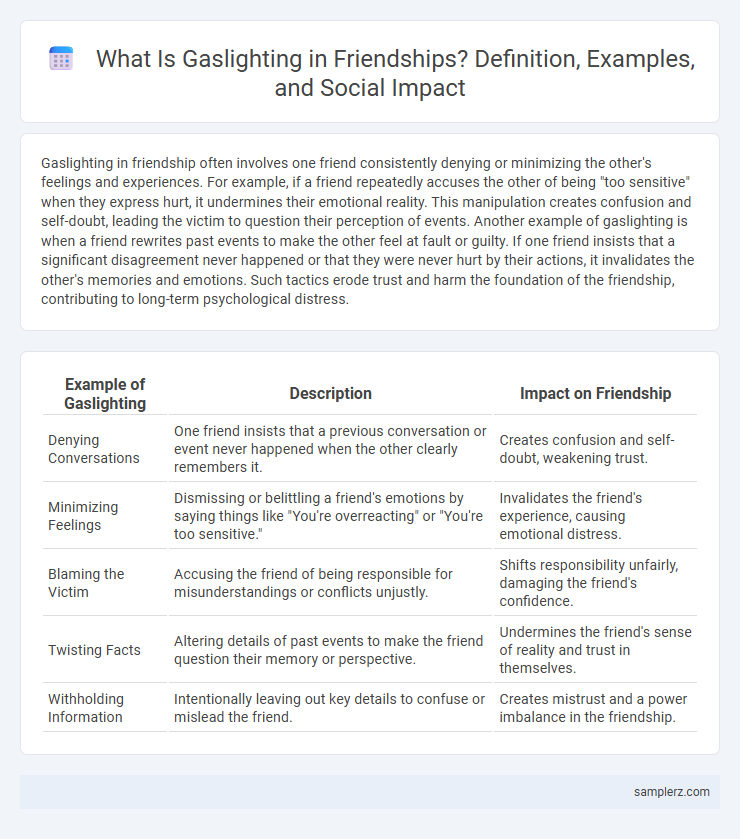Gaslighting in friendship often involves one friend consistently denying or minimizing the other's feelings and experiences. For example, if a friend repeatedly accuses the other of being "too sensitive" when they express hurt, it undermines their emotional reality. This manipulation creates confusion and self-doubt, leading the victim to question their perception of events. Another example of gaslighting is when a friend rewrites past events to make the other feel at fault or guilty. If one friend insists that a significant disagreement never happened or that they were never hurt by their actions, it invalidates the other's memories and emotions. Such tactics erode trust and harm the foundation of the friendship, contributing to long-term psychological distress.
Table of Comparison
| Example of Gaslighting | Description | Impact on Friendship |
|---|---|---|
| Denying Conversations | One friend insists that a previous conversation or event never happened when the other clearly remembers it. | Creates confusion and self-doubt, weakening trust. |
| Minimizing Feelings | Dismissing or belittling a friend's emotions by saying things like "You're overreacting" or "You're too sensitive." | Invalidates the friend's experience, causing emotional distress. |
| Blaming the Victim | Accusing the friend of being responsible for misunderstandings or conflicts unjustly. | Shifts responsibility unfairly, damaging the friend's confidence. |
| Twisting Facts | Altering details of past events to make the friend question their memory or perspective. | Undermines the friend's sense of reality and trust in themselves. |
| Withholding Information | Intentionally leaving out key details to confuse or mislead the friend. | Creates mistrust and a power imbalance in the friendship. |
Recognizing Gaslighting Behaviors Among Friends
Recognizing gaslighting behaviors among friends involves identifying patterns such as persistent denial of events, manipulation of reality, and undermining one's feelings or memories. Friends who engage in gaslighting may consistently dismiss your experiences by saying things like "You're overreacting" or "That never happened," causing confusion and self-doubt. Awareness of these toxic behaviors is crucial for maintaining healthy social relationships and protecting mental well-being.
Subtle Signs of Gaslighting in Close Relationships
Subtle signs of gaslighting in close friendships include persistent denial of shared memories, causing confusion and self-doubt. A friend might downplay your feelings by labeling them as overly sensitive or irrational, eroding your trust in your own perceptions. Consistently undermining your confidence through indirect criticism or contradictory statements creates an environment of emotional manipulation and control.
Common Phrases Used by Gaslighting Friends
Common phrases used by gaslighting friends include "You're overreacting," "I never said that," and "You're just being too sensitive," which manipulate reality and dismiss feelings. These expressions create confusion and self-doubt, undermining the victim's perception of events. Recognizing such language is crucial for maintaining healthy and trustworthy social relationships.
Manipulation Tactics Friends Use to Distort Reality
Gaslighting in friendship often involves manipulation tactics such as denying past conversations or events to make the friend question their memory and perception. Friends may consistently minimize feelings, label concerns as overreactions, or twist facts to create confusion and self-doubt. These behaviors distort reality, undermining trust and emotional stability within the friendship.
Emotional Impact of Gaslighting in Friendships
Gaslighting in friendships often leads to confusion, self-doubt, and a profound erosion of trust, impairing emotional well-being. Victims may experience anxiety, depression, and a diminished sense of self-worth as their perceptions are repeatedly invalidated. This emotional manipulation creates a toxic dynamic that undermines healthy communication and authentic connection between friends.
Real-Life Examples of Gaslighting Between Friends
A common real-life example of gaslighting in friendship occurs when one friend repeatedly denies events or conversations that the other clearly remembers, making them question their own memory and perception. For instance, a friend might insist they never said something hurtful despite evidence, causing emotional confusion and self-doubt. This manipulation undermines trust and can lead to lasting damage in the friendship.
How Gaslighting Can Damage Long-Term Friendships
Gaslighting in friendship often involves one friend consistently denying or twisting facts, making the other question their own memories and feelings. This manipulation erodes trust, leading to emotional distress and confusion that can fracture even long-standing bonds. Over time, the victim may withdraw or become overly dependent, undermining the foundation of genuine connection and mutual respect essential for lasting friendships.
Steps to Address Gaslighting in Social Circles
Recognizing gaslighting in friendships involves identifying manipulative behaviors such as denial of facts, invalidation of feelings, and consistent blame-shifting. To address gaslighting, set clear boundaries by communicating your experiences assertively and seeking support from trusted friends or mental health professionals. Maintaining self-awareness and documenting incidents can empower you to protect your emotional well-being within social circles.
Setting Boundaries with Gaslighting Friends
Setting boundaries with gaslighting friends involves clearly communicating personal limits and recognizing manipulative tactics such as denial, blame-shifting, or trivializing feelings. Maintaining firm boundaries reduces emotional harm by preventing gaslighting behaviors from distorting reality and undermining self-confidence. Consistent reinforcement of these limits fosters healthier interactions and encourages accountability in toxic friendships.
Healing from Gaslighting Experiences in Friendships
Healing from gaslighting experiences in friendships involves recognizing manipulation tactics such as persistent denial, blame-shifting, and invalidation of feelings. Establishing strong personal boundaries and seeking support from trusted individuals or professional counselors can significantly aid emotional recovery. Rebuilding self-trust and developing awareness of healthy communication patterns are crucial steps toward restoring confidence in future relationships.

example of gaslighting in friendship Infographic
 samplerz.com
samplerz.com